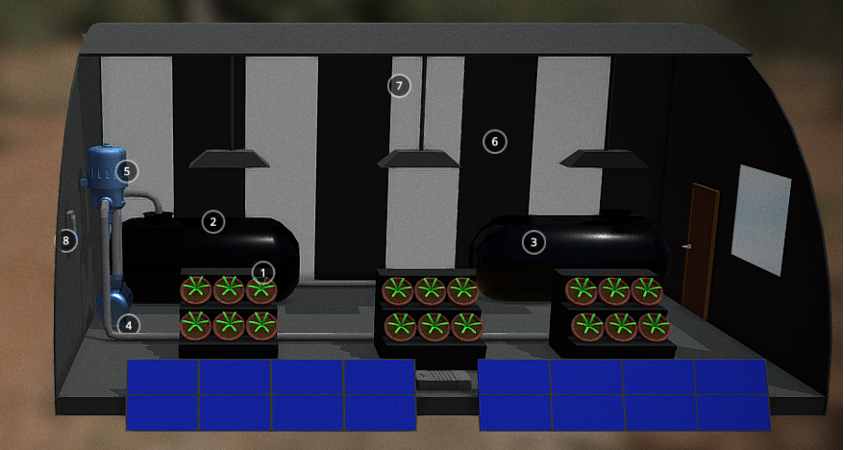Greenhouse in a Box
Greenhouse in a Box is a transportable, off-grid, mini growing unit for year-round fruit and vegetable crop production. This innovative, mini growing unit is the resulting outcome from over 8 years of comparative study between different sustainable passive solar greenhouses by our Assiniboine Community College applied research team.
This greenhouse will overcome climate (cold or below zero temperatures) and soil restrictions (marginal land) and provide an opportunity for anyone to grow fruit and/or vegetables year-round, even in areas of limited daylight and extreme temperatures. This greenhouse addresses food security issues in Canada by extending the crop growing season from May - September to February - December. Greenhouse in a Box is designed to withstand the winter conditions in the north, enabling communities to grow fresh food in regions where crops would normally struggle to grow
The planned unit will have vertical growing walls, each 2 feet wide x 6 feet tall with 30 six inch grow cups per wall (240 cups total). Each grow cup will support an individual plant for a total crop of 240 plants. Drip fertigation will be pumped to each individual plant/cup 3x daily ensuring sustained watering of each plant.
The vertical growing walls will be enclosed in an insulated, passive-solar 16’ long x 10’ deep x 12’ high modified greenhouse, designed to retain heat using thermal mass and insulation. As a result, it will be possible to grow crops year-round with solar energy alone, even when it's freezing outside, in regions where doing so would otherwise be impossible without large energy inputs of fossil fuels.
With electrical power needs for LED lighting and fertigation system, and supplemental heating if needed, met by a small plug & play solar energy collection unit, the greenhouse will grow crops at least 10 months of the year, if not all year.
Rain and snow melt are collected by externally placed eavestroughing which funnels the moisture to black barrels within the greenhouse structure. The barrels are black to restrict algae growth and are also a heat sink source. This moisture is then used for the fertigation of the crop plants
The unit will optimize inside growing environmental conditions by using energy balancing black and white wall panels to manage passive solar energy during colder and warmer months for crop cultivation in the growing unit. Together the individual pieces of the mini growing unit will create a complete growing system available for growing in any location or climate.
The proposed mini growing unit will be totally off-grid, adaptable to any location or climate, and electrical needs will be met by a plug and play solar energy system.

Greenhouse in a Box is the unique, self-supporting, solar prototype that will begin its year-long trial starting the summer of 2024, continuing through our prairie winter, and finishing the following summer. In 2025, once the trial is complete, the intention is to move forward and offer our Greenhouse in a Box – so aptly named as all building material and equipment will come ready to assemble – to individuals, communities, and organizations. This will be a concrete step forward in addressing the lack of available fresh, healthy produce in isolated regions.
- Vertical growing wall – the innovative design allows for vertical drip irrigation - 3 times per day for 3 minutes each time - to each plant while maximizing sunlight and growing space. This will support plants to grow organically with 97% less water and no chemical or pesticide usage.
- Irrigation System - Rain and snow is collected by external eavestroughs which flow into two indoor water reservoir tanks in the greenhouse. The water is then pumped through a dosimeter, adding fertilizer to the water which is then pumped through tubes into the individual plant pots.
- Water Reservoirs - Incoming precipitation is stored in two large, black plastic water reservoirs designed to prevent the growth of algae in the water.
- Marine 24-volt pump - A Marine 24-Volt Pump is used to draw water out of the reservoirs, into, and through the irrigation system.
- Dosimeter - Water is pumped through a dosimeter which mixes fertilizer with the water.
- Lighting – LED lighting is used to reduce energy consumption.
- Wall Panels - The wall panels are reversible, with a white side and black side. This allows Greenhouse in a Box to retain more heat during winter using the black wall panels, and reduce greenhouse heat during the summer using the white wall panels.
- Solar collection unit - The solar energy collection unit consists of two solar panels (shown in blue) which are 3.5 feet by 7 feet and are attached to the south facing pony wall of the greenhouse. The solar panels are connected to a charge controller located inside the greenhouse which then sends the energy to the two lithium iron phosphate storage batteries. This converted energy powers the electrical outlets where the pump and lights will be plugged into.
